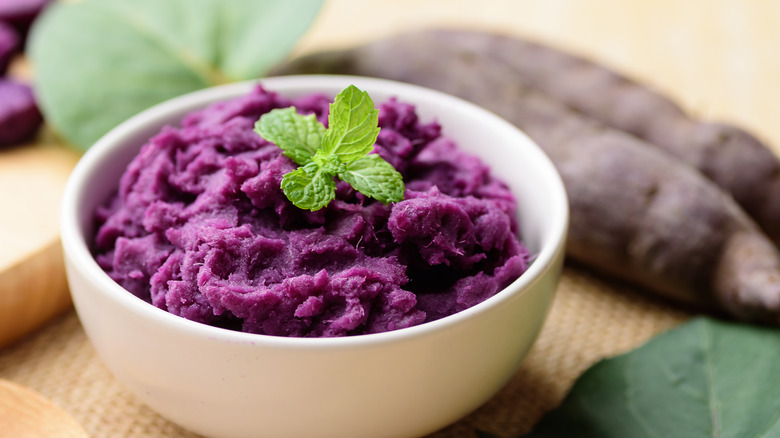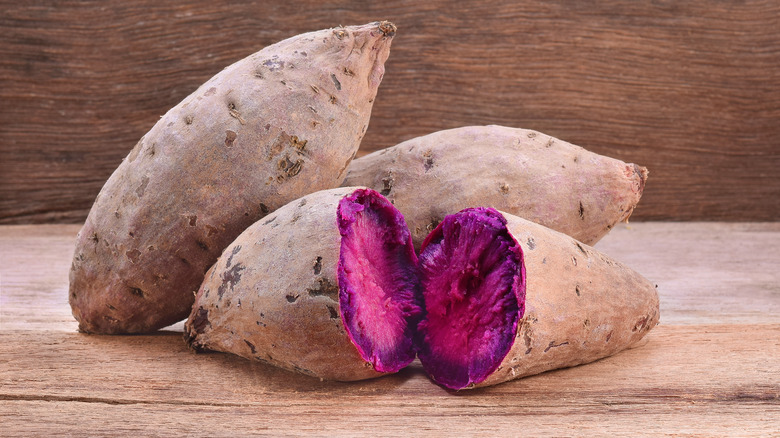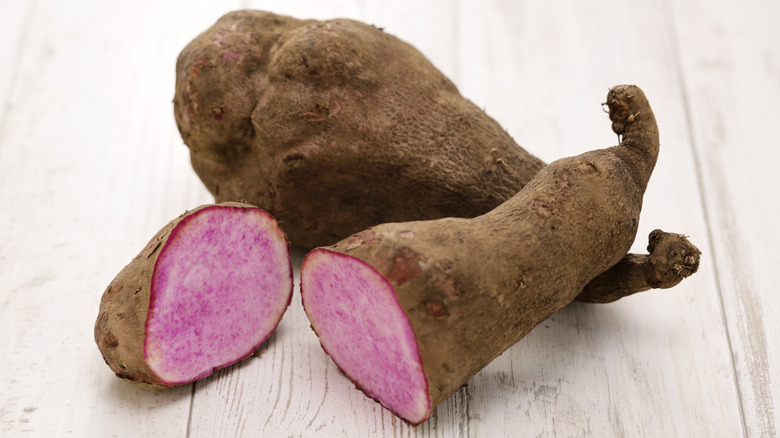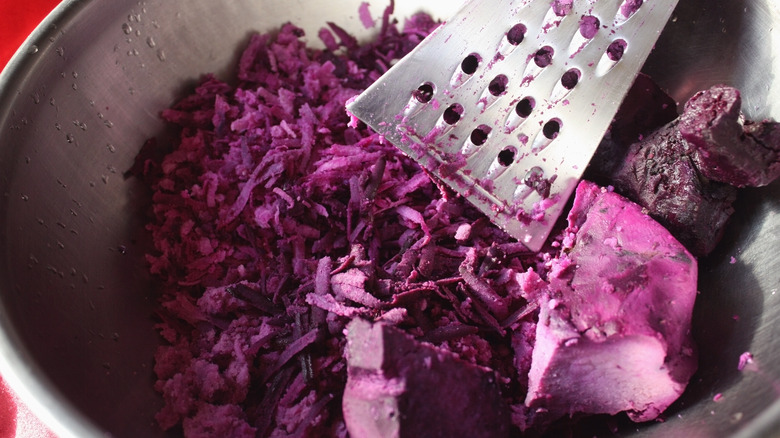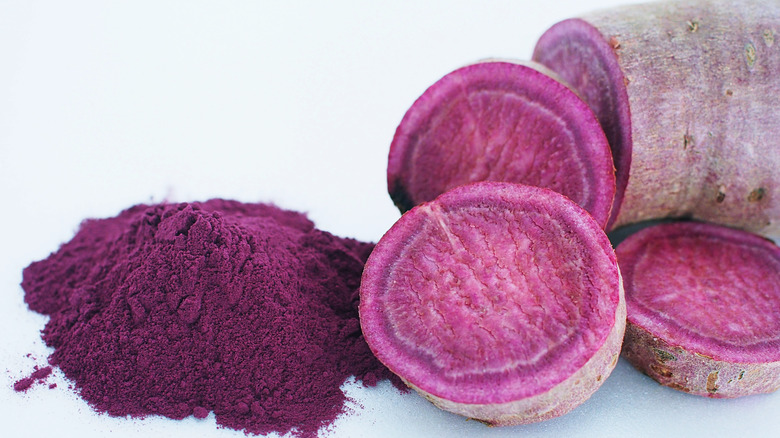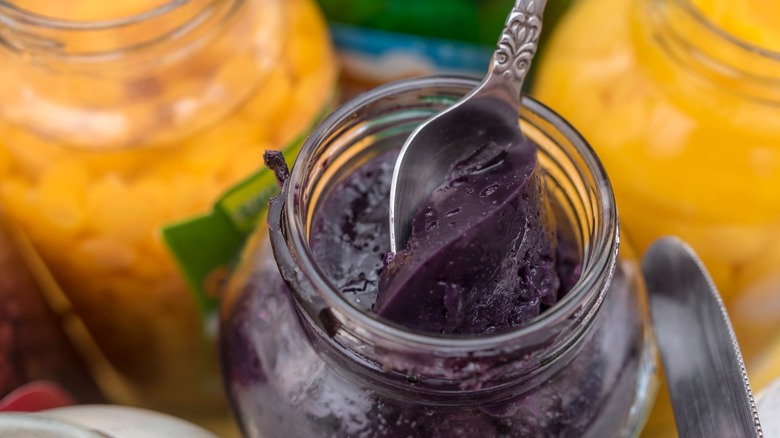Purple Sweet Potatoes Vs. Ube: What's The Difference?
With a sweet, nutty taste and deep purple insides, purple sweet potatoes and ube are quite easy to mistake for one another. It doesn't help that many dessert recipes involving either ingredient treat them as interchangeable, and doing a search for one will get you many results for both when shopping online. That's to say nothing of the fact that they both have a prominent history and significance in Asian and Polynesian cultures. At some point, you might find yourself wondering if there's any real difference between the two purple sweet starches at all, or if they're simply variants of the same plant the way that all the different types of potatoes are.
However, unlike the incredibly diverse but botanically indistinguishable varieties of potatoes, purple sweet potatoes and ube are two completely different kinds of plants with clear distinguishing features. The purple sweet potato traces its origins to Central America and is a part of the morning glory family of plants, while ube is a true yam native to Southeast Asia and has been a part of Polynesian cuisine for thousands of years. Moreover, the two root vegetables have slight differences in texture and taste that make each of them better suited to different purposes — as well as different availabilities and nutritional content that you should consider before choosing either for your next purple sweet treat.
What is a purple sweet potato?
To be clear, there is no one single purple sweet potato: All of them are cultivars of the sweet potato plant that originated in different places. Named ipomoea batatas, the sweet potato is a versatile root vegetable native to tropical regions of Central and South America with a cultivation history stretching back as early as 2500 B.C.
There are two especially prominent purple sweet potato varieties, both of which have vivid purple flesh that becomes a shade deeper after being cooked. The more recent of the two is the Stokes Purple, which was patented in the mid-2000s and sports a thin, light-to-medium brown skin over its vibrant insides. The older purple sweet potato variety — which actually usually has a beige-ish skin — is the Okinawan variety. First cultivated in Okinawa in the 17th century, it has since become a popular local delicacy known as the beni-imo in Japanese.
One thing to note is that the Okinawan sweet potato is not to be mistaken for the classic Japanese Murasaki sweet potato (which has purple skin and golden flesh) or the Hawaiian sweet potato. While often incorrectly conflated, the Okinawan sweet potato is distinct from the true Hawaiian sweet potato variety known as the uala. These potatoes range in color from orange to light lavender and have been a part of Hawaiian culture since ancient times after being brought over by early Polynesian voyagers.
What is an ube?
In contrast to the varieties of sweet potatoes that have made their way over to Asia and Oceania from the Americas, ube is a distinct and singular plant completely native to Southeast Asia. Scientifically named Dioscorea alata, the ube is a true yam — as opposed to some varieties of sweet potatoes which have been colloquially dubbed yams — with a tough, bark-like skin, irregular shape, and flesh that ranges from extremely light lavender to vibrant purple. It's one of the most recognizable staples of Filipino cuisine, thanks to its long history in the region. The most common application is to make ube into ube halaya, a sweetened ube jam that also serves as the base for many other ube-based desserts.
Ube has become especially popular outside of the Philippines recently, gaining momentum as a trendy superfood due to its health benefits as well as its natural color. You may have seen ube available as a flavor for ice cream, pancakes, cakes, mochi, and other various sweets at your local grocery store as more North American brands pick up on the trendy new purple flavor. Unfortunately, this rise to international popularity has coincided with decreasing yields due to climate change. Ube with truly vibrant purple flesh — the very feature that makes it so recognizable as well as popular — has become scarce enough that some popular ube halaya brands have resorted to selling white ube jam.
Ube has a thicker and more moist texture
In a general sense, ube and purple sweet potatoes have a very similar texture and flavor profile with few differences. They're both creamy and soft when cooked, making them great for mashing — either for eating the mashed dish on its own, as with ube halaya and mashed sweet potatoes, or for incorporating into other sweet desserts like cake, ice cream, cookies, and more. Both ube and purple sweet potatoes are also subtly sweet with an earthy and nutty taste that pairs excellently with other sweet flavors like chocolate, milk, coconut, and vanilla, as well as tea and coffee.
But anyone who's familiar with both will know that despite the striking similarities, ube and purple sweet potato aren't perfectly interchangeable. For one, ube has a notably subtler sweetness with stronger hints of vanilla and taro-like nuttiness. For another, purple sweet potatoes have a drier texture that results in a fluffy mash, not unlike regular potatoes; meanwhile, ube is more moist and firm and can have a mealy texture depending on how you cook and prepare it. The traditional way of breaking down cooked ube is actually grating it like cheese instead of mashing like potatoes, possibly to cut up the stubborn fibery strands present inside the flesh. However, cooked ube is more than soft enough to mash the same way you would a sweet potato if you don't mind the strands and prefer the chunkier texture.
Purple sweet potatoes are easier to come by in North America
Generally speaking, ube is harder to come by in North America than purple sweet potatoes for two reasons: geography and growth time. The latter has an obvious significant impact on availability — where ube takes a full year to mature, purple sweet potatoes can grow within three to seven months and are faster to hit the produce shelves. They also aren't quite as picky as ube when it comes to seasons, with Stokes Purples generally being available from September to April and the Okinawan variety being produced year-round.
For those in North America, the California-grown Stokes Purple might be much easier to come by than the Okinawan variety, and the same is true of its availability compared to ube. Ube thrives in warm, humid climates that generally restrict outdoor growth to parts of the U.S. like Florida and southern California or Texas; unfortunately, it also seems ube is an incredibly hardy and somewhat aggressive plant classified as an invasive species in Florida, and not likely to be cultivated in other parts of the U.S. given the dual concerns about containment and appropriate growing weather. So all in all, you'd have to be very lucky to chance upon fresh imported ube at your local Asian grocery store. More often than not, ube is offered in grated and frozen portions as well as powdered varieties and extracts.
Ube has more vitamins and less sugar
If you're interested in what nutritional benefits ube and purple sweet potatoes might offer, you might be pleased to find that they're more than just colorful and sweet additions to your baked goods and lattes. The rich purple in both tubers comes from oodles of anthocyanins, the same antioxidants present in other healthy foods like blueberries. This vivid, natural pigment is a champion when it comes to heart health, reducing the risk of cancer and diabetes as well as boosting cognitive function (via Healthline).
Aside from their shared antioxidant content, ube and purple sweet potatoes have a similar nutritional profile with a few key differences to keep in mind. According to the USDA, 100g of purple sweet potatoes and ube have similar values in calories, protein, carbohydrates, fiber, and calcium, with sweet potatoes containing slightly more protein, potassium, and calcium while ube has more of nearly everything else, including vitamin C. As a tradeoff, purple sweet potatoes also pack in a little more sugar — something to be aware of when considering using it as a substitute in a recipe that calls for ube.
Depending on your individual dietary needs, either ube or purple sweet potatoes may be better suited to your daily health. But remember that any health benefits carried by either tuber can be vastly undercut by loads of added sugar that you might find in sweet recipes, so keep an eye out for additives when making or shopping for purple-themed foods.
